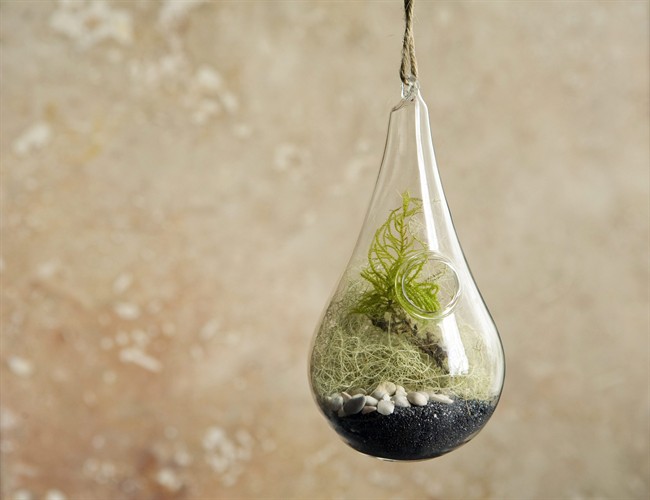Remember those old elementary-school terrariums – lidded aquariums filled with plants or plastic soda bottles growing science projects?

Today’s aquariums are chic and rule-busting, popping up in interior design and gardening stores. They now include many different materials and plants. In fact, today’s miniature worlds under glass can be simple still lifes – no living parts need participate.
That’s some kind of easy.
“There’s a little maintenance to it, but it’s very, very low maintenance,” says Amy Bryant Aiello, who owns a terrarium shop, Artemisia, with her husband, Michael Aiello, in Portland, Ore. She also wrote a book, “Terrarium Craft” (Timber Press, 2011), that includes how-to steps for building a beautiful and long-lasting terrarium, and 50 projects for inspiration. She uses materials including mosses and lichen, quartz crystals, river rocks, seashells, glass pebbles and driftwood.
“The idea is to play with the materials and enjoy the process itself,” Aiello says in her introduction.
More examples of grown-up terrariums are presented in Tovah Martin’s book “The New Terrarium” (Clarkson Potter, 2009).
A well-planted terrarium can thrive for many years, provided you have the right materials and location.
Some plants, such as ferns, prefer bright, indirect light, whereas a succulent, such as cactus, prefers a stronger, direct light. Air plants, which don’t root in soil and are handily watered – with a good soaking every week or two – do well in terrariums, Aiello says. Houseplants in five- to 10-centimetre pots work best.
- ‘We’re rich’: Couple now millionaires after playing same lotto numbers for 38 years
- Trudeau calls New Brunswick’s Conservative government a ‘disgrace’ on women’s rights
- Housing affordability just improved in Canada – mostly in these expensive cities
- Loblaw agrees to sign grocery code of conduct. Why it took so long
Instead of the traditional layering of rock, charcoal and soil in a terrarium, Aiello uses high-quality sand. Depending on the plant, she may use some soil to help it get established. Otherwise, she leans toward the many-coloured, sterile sands, often layered with pebbles or shells, for their visual impact through clear glass.
Her favourite sands are garnet, which is reddish-purple; hematite, which is black; pure quartz, which is creamy-white; and Monterey beach sand, which is tan in colour.
Beach and play sands are a no-no in a terrarium, says Aiello, because they’re not sterile. “Dirty” sand must be washed, screened and kiln-dried to be safe for plants. The Monterey beach sand, often used in fish aquariums, is available this way.
Kathie Helmericks has been making terrariums for about a year, and they now fill the tabletops and shelves of her Fort Collins, Colo., home. She recently started a business, Glass Garden Terrariums, and sells her verdant creations in small Denver shops, including Ironwood Collection and Moondance Botanicals.
“It’s been an obsession with me,” says Helmericks. “It’s really fun.”
Helmericks uses sterile soil in her terrariums. She warns that “unclean” soil might harbour fungus gnats or their larvae, and notes that bugs also can be introduced into a terrarium by plants. Inspect healthy plants before introducing them into a terrarium, she advises.
The glass container can amount to half the cost of a store-bought terrarium, and can run into the hundreds of dollars.
Helmericks wanders thrift shops and flea markets in search of unique glass containers for her biospheres. Aiello recommends Ikea for inexpensive glassware. She uses vessels with small openings for non-living terrariums. Coloured sand, dried moss, seedpods and shells are just a few things that can be used.
“I still think it’s a little world,” says Aiello.
Terrariums can be enclosed, or open at the top for air flow, Aiello says. An open, “dry” terrarium – planted with drought-tolerant succulents – only needs watering every two to three weeks, depending on climate. A closed, “wet” terrarium is a little trickier: Helmericks warns against over-watering when planting. She opens her closed terrariums every morning for an hour to let them breathe and to release condensation.
“That’s how most people kill terrariums,” says Helmericks. “They over-water, and they don’t take the lids off.”
Aiello sees renewed interest in terrariums as pushback in a fast-paced, technologically driven world.
“When people come into my shop, it’s filled with all these beautiful things from nature, and it feeds something in them that nothing else can,” she says.
—
Online:
A few places to shop online for a terrarium, usually sold as kits, are Artemisia’s site Collage with Nature, Flora Grubb Gardens and Twig Terrariums. For inspiration, consult The Fern & Mossery blog, and Seed to Stem, Westborough, Mass.-based floral designers.
http://artemisiaon28th.blogspot.com




Comments